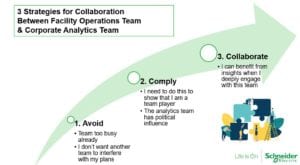In this blog series, I’ve explained how power analytics technology and power management applications can help improve your facility’s resilience in the ‘New Electric World.’ Now, let’s go further to look at how integrating your power data at the enterprise level can bring more transformational insights.
We already discussed the value that digitizing your electrical network can bring to your facility team and service partners. High-quality data from your electrical network analyzed at each level – from devices to the cloud – will provide them with the deep insights needed to optimize the performance of your electrical network. But, did you know that this same power and energy data is also of great value to the rest of your organization?
A common refrain in recent years is that “data is the new oil.” Most organizations have already begun to leverage the value of their enterprise data. It is now common for a central team, led by a Chief Data Officer (CDO), to gather and analyze data from every part of the organization. This central analytics team integrates many types of data, and then extracts insights that span organizational silos and helps the business become more efficient, resilient, and ultimately, more competitive.
For example, analytics teams combining energy and power data with production output and shift data can help a manufacturing department identify equipment use patterns that waste energy or create power reliability issues on the production line. Power and energy data alone can not yield these insights.

Supporting Enterprise Insights
The same entrepreneur who coined the phrase about data being the new oil also shared that “data must be broken down and analyzed for it to have value.” Even the best analytic tools will fail if the data is not accessible. As noted by Harvard Business Review, “In today’s digitized economy, the ability to use data represents a real and essential competitive advantage. [You can] expect 80% of the work in becoming data-driven to be integrating your data and making it available to meet the needs of your company as a whole.”
Forbes Technology Council recognizes that to “establish a single source of truth” from enterprise data requires overcoming the data silos within your company. This means a culture change by driving “collaboration across business units, departments and levels of hierarchy [requiring] establishment of trust and accountability.”
Imagine what this will mean for your facility team. How will you respond to your CDO analytics team when they request power and energy data from across your entire power management system? Here are three strategies for how you can respond, in increasing order of their value to your team and your organization as a whole.

Strategy 1: Avoid the Request
When the CDO team requests data, the first temptation may be to ignore or decline the request. Afterall, providing access can mean extra time and stress for your team, which is already strapped for resources. You may also be concerned the data will be used out of context to produce incorrect conclusions that drive bad decisions or create more work for your team. Additionally, team members may feel that their jobs are threatened because they may perceive that an external team is using analytics to replace their expertise.
But what will happen if you avoid the request? First, your organization cannot benefit from new corporate-wide insights that can be unlocked by your power system data. Second, other participating teams will get the attention of, and valuable insights from, the CDO team – while your team receives nothing. Finally, your team may be seen by the C-level as being uncooperative.
Strategy 2: Comply with the Request
This strategy involves complying with the ‘letter’ of the request by exerting a minimal effort to provide only the data that was asked for. The goal is simply to get this task ‘off your desk’, so you can return to your core responsibilities. As the CDO analytics team has influence at higher levels in the enterprise, complying with the request also means that you will be viewed as being cooperative.
Complicating your ability to comply with your CDO requests is the fact that some power management systems make it difficult to share data. As well, without fully understanding the CDO team’s needs, your supplied data may not be of sufficient quality (e.g. missing or duplicate data) or conformity (e.g. wrong naming and unit conventions). Therefore, it is important that your team uses an open platform with good data quality and data integration capabilities. This will provide the CDO team with a variety of ways to access your data in the formats required.
Strategy 3: Collaborate Closely
This strategy will be used by teams that fully embrace the idea that the CDO team can add significant value when you collaborate. Groups at this level regularly hold cross-functional meetings to understand what each team needs to be more effective.
With this approach, you actively invest to improve the quality and context of your data so that the analytics team can access and process it. This investment may include purchasing new devices or ‘edge’ system features that generate specific types of data or cover areas of your facility that are currently not being monitored. With collaboration, the CDO team will more deeply appreciate the value of your data, which may even lead them to co-fund some of your purchases.
Collaboration at this level will generate transformational outcomes for your team and business. You may also find that your organization transforms as a result; for example, by adding a data scientist to your team who can take the insights from the CDO team even further.
Using this collaboration model can be challenging due to the cultural status quo. Managers should look to success stories, inside and outside your industry for inspiration. These examples can help your team members change the way they view their job security. As your team takes advantage of powerful new insights, they will become more data-driven and focused on higher-value activities that make them more valuable to the organization than they are today.
Learn About Power Analytics, EcoStruxure, and Much More
Schneider Electric is working to deliver the open platforms you need for a more collaborative future. The IoT-enabled EcoStruxure™ Power architecture supports digitized power distribution, enabling enhanced connectivity, real-time operations, and smart power analytics. EcoStruxure Power Advisor is a proactive, analytics-based service for your power management system, delivering optimized energy performance, power reliability, and resilience.




Conversation
Recalling the ignominious death of ‘Activity Based Costing’ and related initiatives, I have a feeling that history is poised to repeat itself.